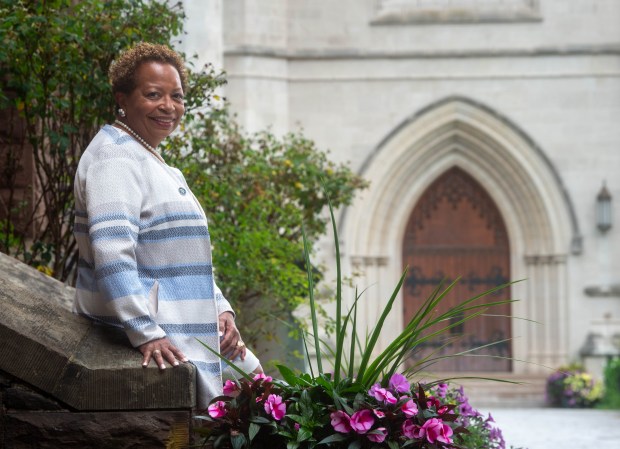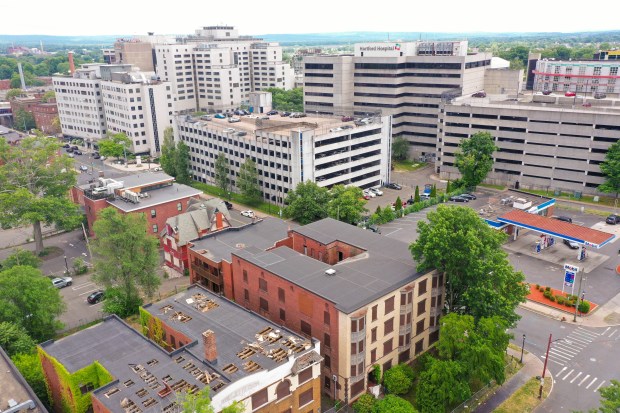HARTFORD — Not long after being appointed president of Trinity College in 2014, Joanne Berger-Sweeney made it known that she’d like to serve on the board of directors of Hartford HealthCare, which operates Hartford Hospital and six others in Connecticut.
Berger-Sweeney is a neuroscientist with a PhD in public health so the fit may seem obvious, but she was thinking well beyond: both Trinity and Hartford Hospital have been part of city since the early 1800s — and have made commitments, Berger-Sweeney said, to “being in and of Hartford.”
Now, after serving eight years on Hartford HealthCare’s board, Berger-Sweeney has been appointed its chair and will lead the board of one of the largest and most powerful health care systems in the state.
In a recent conversation with The Courant, Berger-Sweeney often draws parallels between Trinity and Hartford HealthCare, remembering her first impressions of both when she first arrived in Hartford as she moved on from Tufts University, where she was dean of Arts and Sciences.
“We were both anchor institutions,” Berger-Sweeney, now 64, recalls. “We have physicians or tenured faculty members that are at the heart and soul of delivering the product, but sometimes could be staid in their ways about how they did their jobs. Both organizations had leaders come in that wanted to innovate, but at the same time being very committed to the neighborhoods in which we are settled.”

Hartford HealthCare has placed innovation at the center of the organization and has expanded its network of urgent care centers to shift routine visits away from the emergency rooms of its hospitals. Trinity, which recently celebrated its bicentennial, has worked to shed a historical, elitist image. Both institutions have expanded into downtown: Trinity partnered in Liberal Arts Action Lab on Constitution Plaza and the health system moved into a $14 million headquarters on Pearl Street.
A descendant of enslaved people, Berger-Sweeney — the first African-American and woman to ever lead Trinity — proudly points to the fact that she is the third generation of her family to graduate college. Berger-Sweeney’s father was an attorney and her mother was the president of the Girl Scout Council in Los Angeles, where Berger-Sweeney grew up.
One of the most pivotal experiences early on was as an exchange student before she entered college, living with a family in Malaysia.
“And that very much shaped my worldview, l think, on people in different countries and what it means,” Berger-Sweeney said. “We’re all just people if we are willing to work together.”
During her time in Malaysia, Berger-Sweeney stayed with the head of the state in Malaysia where she was visiting, who was also the Muslim leader in the region.

Cloe Poisson / Special to the Courant
Hartford HealthCare moved its headquarters and hundreds of employees to the office tower at 100 Pearl Street in downtown Hartford after a $14 million renovation.in 2022. Waves of colorful strips adorn the ceiling in the new facility. (Cloe Poisson/Special to The Courant)
“So that means throughout my life, even though I was raised as a Christian, you could not say to me that Muslims were this or that or all the negative connotations because I’d lived with a family that had opened up their home to this high school student from America and this Black American.”
What follows is a condensed conversation with Berger-Sweeney, edited for length and clarity, on her new role as chair of Hartford HealthCare, diversity and Hartford.
Q: The pandemic exposed wide disparities in access to health care for Black, brown and indigenous communities. A recent study by the Kaiser Family Foundation showed wide gaps continue to persist. Change may not come overnight, but do you see some progress being made?
A: I do see progress. There’s still a ways to go, without question. But sometimes, the first important step is recognizing the problem, recognizing there is a gap. I was listening to a story today about a Black woman in track and field who died in childbirth, and it was bringing up the differences in outcomes in childbirth between Black women and white women. So as I said, the first step is recognizing the problem and understanding the problem because, otherwise, you’re just throwing solutions at a problem that you don’t really understand.
And since I have been on the board at Hartford HealthCare, they have hired someone who specializes in looking at gaps, these racial gaps and some of the issues related to diversity. That position didn’t exist before. We now have the ability and some resources to shine light on the problem, and that’s where we can come together to work on better solutions. People have to feel as though they are a part, that they’re engaged and that people care about those issues to want to participate.

Q: Hartford Hospital serves a city population that is broadly impoverished. The hospital has cited stunning statistics that show the life expectancy in Hartford’s Northeast neighborhood as 68.9 years, compared with 84.9 years in West Hartford Center. The hospital is addressing the need for community-based health services with its clinic on Jefferson Street, but the hospital said more clinical space is needed. What do you see as the most pressing health need for Hartford residents?
A: What I can tell you is troubling to me is access broadly and particularly with primary care physicians. You can’t get primary care physicians to be located here in Hartford. I cannot find a primary care physician in the city of Hartford. I have to go to West Hartford, which is the closest, but for a while, I was going even farther out to get primary care. We’ve got to figure out ways — and it’s not just Hartford HealthCare.
And we know, statewide, for example, the crisis that we have with mental health care services and not just for young adults, but teens and folks even younger than that — preteens in need of mental health and behavioral health care. So, there are just so many mismatches right now between what we need and our health care system. That’s the meta issue that all of us are dealing with. That’s not just Hartford HealthCare, but health care in the U.S.
Q: How is Hartford HealthCare reaching out to the Hartford community?
A: Hartford HealthCare is very involved in trying to address the issue of gun violence and, in particular, the Brother Carl Hardrick Institute, an organization that Hartford HealthCare supports. It is focused on gun violence and does a lot of its work in the north part of Hartford. It’s people on the ground trying to understand the root causes of gun violence and clearly to try and shift the curve.
On a micro level, there is someone working with the hospital to provide barber services to homeless people. How can you get a job if you clean up and shave and have a haircut? So, I have seen them involved in very direct service issues in the community.

Q: How does an urban institution like Hartford Hospital expand to respond to 21st century innovation yet respect the historic buildings that still exist surrounding the campus?
A: Interestingly, it’s the same issue that Trinity College has. I mean, we’re not going to tear down the Long Walk. We are in a historic district, but we need to think about how do we expand what we do? So one way is through renovation and not just expanding the footprint. And one of the commitments that I made during Trinity’s strategic planning process that I don’t want the built footprint of Trinity to grow.
So, if we’re going to expand something in the future, how are we thinking about what we are going to reduce in the future? And it’s a bit of the concept to me of the importance of reusing and not just redoing and that, if possible, can you renovate rather than knock down?
The pandemic was so challenging to health care that we didn’t spend huge amounts of time talking about the footprint and about whether we were going to grow. To be honest, it is a balance because sometimes when we think here at Trinity, some of our older buildings that we deal with really should be torn down. It would be environmentally more efficient to rip it down and build a new one. Is that more important than saving the history of a historic building?
Those are challenges and balances that all of our organizations face. And I’m not sure there’s any right answer, except that doing nothing is not the right answer.
Q: You also serve as chair of the Capital Region Development Authority’s housing committee that considers requests to finance housing projects in and around Hartford. What is the most pressing housing need in the city?
A: I still believe that one of the biggest housing needs is the affordable home. Homeownership is not just the American Dream, it’s the way Americans have built wealth. And as much as I like renovating apartments — and understand the needs that people have to be in good, clean apartments in the central district — I do often ask about: are there possibilities for some portion of it being homeownership?
Another significant need in Hartford is middle class anything. Hartford is the extreme: the very poor on one side of town and the wealthy on the other and not a lot available in between. So, I have also wondered if there can be in some areas some focus on housing that middle income people would be interested in. Maybe they don’t have kids. Maybe they aren’t tied to a particular school district. But if your middle class are faculty, they don’t live in Hartford for the most part because there aren’t a lot of places where middle class people want to be in Hartford. So, we have an opportunity to work on that as part of CRDA.
Q: What is the biggest challenge for urban hospitals like Hartford Hospital in a dramatically changing health care industry?
A: When you can’t rely on patient care in the hospital supporting primarily the entire health care system, so where does it come from, then? Yeah, well, some of it is going to come from the government. But just like in higher education, we are being asked to be more innovative about what and how we do things. And it’s not that we are trying to do side businesses. We are trying to create systems that are more innovative that continue to deliver what we want, whether it’s in health care or education, but do so in a manner that might be more cost effective or provide different sources of income such that we can continue to support the entire system.
Kenneth R. Gosselin can be reached at kgosselin@courant.com.



